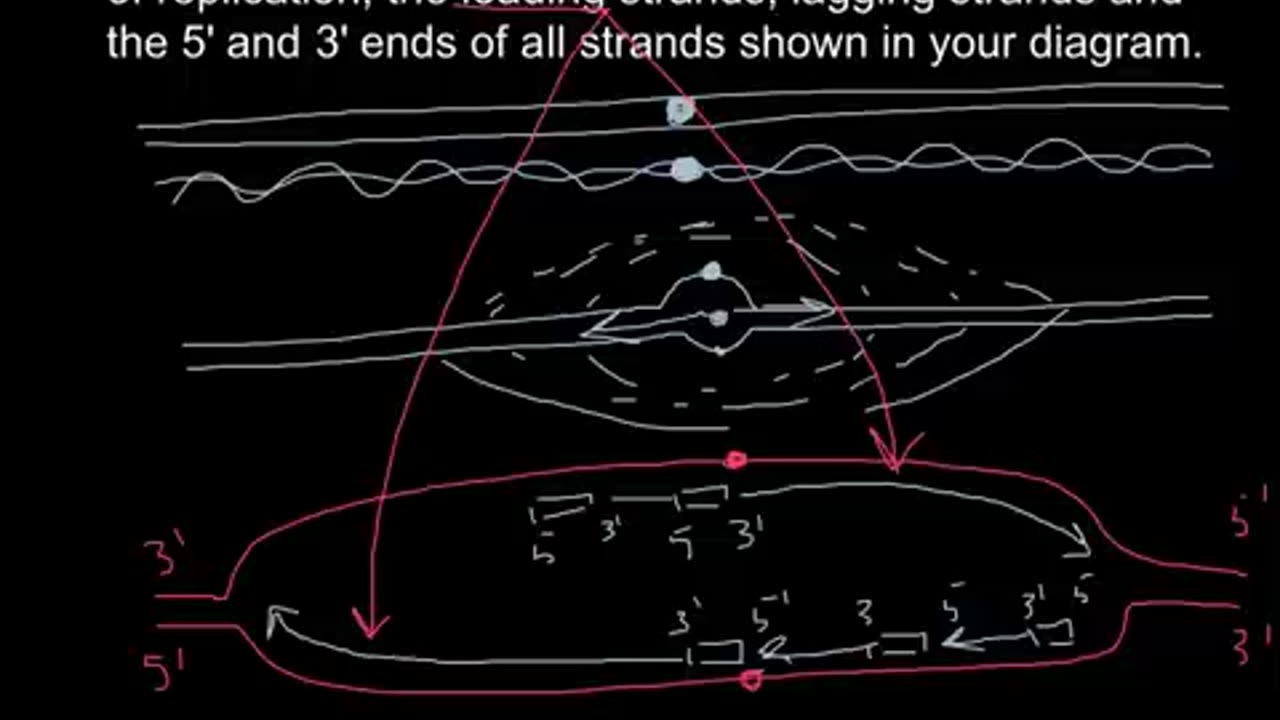Premium Only Content

What is DNA Replication bubble and how it works?
DNA replication is the process of producing two identical copies from one original DNA molecule. This biological process occurs in all living organisms and is the basis for biological inheritance. DNA is composed of two strands and each strand of the original DNA molecule serves as template for the production of the complementary strand, a process referred to as semiconservative replication. Cellular proofreading and error-checking mechanisms ensure near perfect fidelity for DNA replication.
In a cell, DNA replication begins at specific locations, or origins of replication, in the genome. Unwinding of DNA at the origin and synthesis of new strands results in replication forks growing bidirectionally from the origin. A number of proteins are associated with the replication fork which assist in the initiation and continuation of DNA synthesis. Most prominently, DNA polymerase synthesizes the new DNA by adding complementary nucleotides to the template strand.
DNA replication can also be performed in vitro (artificially, outside a cell). DNA polymerases isolated from cells and artificial DNA primers can be used to initiate DNA synthesis at known sequences in a template DNA molecule. The polymerase chain reaction (PCR), a common laboratory technique, cyclically applies such artificial synthesis to amplify a specific target DNA fragment from a pool of DNA.
Replication fork.
Many enzymes are involved in the DNA replication fork.
The replication fork is a structure that forms within the nucleus during DNA replication. It is created by helicases, which break the hydrogen bonds holding the two DNA strands together. The resulting structure has two branching "prongs", each one made up of a single strand of DNA. These two strands serve as the template for the leading and lagging strands, which will be created as DNA polymerase matches complementary nucleotides to the templates; the templates may be properly referred to as the leading strand template and the lagging strand templates.
DNA is always synthesized in the 5' to 3' direction. Since the leading and lagging strand templates are oriented in opposite directions at the replication fork, a major issue is how to achieve synthesis of nascent (new) lagging strand DNA, whose direction of synthesis is opposite to the direction of the growing replication fork.
Leading strand[edit source
The leading strand is the strand of nascent DNA which is being synthesized in the same direction as the growing replication fork. A polymerase "reads" the leading strand template and adds complementary nucleotides to the nascent leading strand on a continuous basis.
The polymerase involved in leading strand synthesis is DNA polymerase III (DNA Pol III) in prokaryotes and presumably Pol ε in yeasts. In human cells the leading and lagging strands are synthesized by Pol α and Pol δ within the nucleus and Pol γ in the mitochondria. Pol ε can substitute for Pol δ in special circumstances.
Lagging strand
The lagging strand is the strand of nascent DNA whose direction of synthesis is opposite to the direction of the growing replication fork. Because of its orientation, replication of the lagging strand is more complicated than that of the leading strand.
The lagging strand is synthesized in short, separated segments. On the lagging strand template, a primase "reads" the template DNA and initiates synthesis of a short complementary RNA primer. A DNA polymerase extends the primed segments, forming Okazaki fragments. The RNA primers are then removed and replaced with DNA, and the fragments of DNA are joined together by DNA ligase.
In eukaryotes, primase is intrinsic to Pol α.DNA polymerase III (in prokaryotes) or Pol δ (in eukaryotes) is responsible for lengthening the primed segments. Primer removal in eukaryotes is also performed by Pol δ. In prokaryotes, primer removal is performed by DNA polymerase I, which "reads" the fragments, removes the RNA using its flap endonuclease domain (RNA primers are removed by 5'-3' exonuclease activity of polymerase I, and replaces the RNA nucleotides with DNA nucleotides.)
-
 2:42:30
2:42:30
TimcastIRL
9 hours agoKash Patel CONFIRMED, Deep State PANICS, Mitch McConnell To RETIRE w/ Kevin Smith | Timcast IRL
166K301 -
 1:04:47
1:04:47
Candace Show Podcast
13 hours agoBecoming Brigitte: The Epilogue
114K145 -
 3:43:51
3:43:51
Alex Zedra
8 hours agoLIVE! Come Play WoT with me!
44.3K11 -
 5:22:49
5:22:49
Drew Hernandez
16 hours agoDOGE EXPOSES $2 BILLION SCHEME LINKED TO STACEY ABRAMS?!
70.1K45 -
 1:27:59
1:27:59
Kim Iversen
11 hours agoRFK Jr Declares No More Cheetos on Welfare? | Yale Confirms Long Covid Is Actually Vaccine Injury!
101K116 -
 1:08:43
1:08:43
The Charlie Kirk Show
8 hours agoTHOUGHTCRIME Ep. 74 — Charlie's Campus Return? Robo-Butlers? Garden of American Heroes?
87.1K18 -
 1:09:53
1:09:53
Slightly Offensive
9 hours ago $7.59 earnedIs the US Headed for MORE WAR Under TRUMP? | Guest: Scott Horton
51.3K13 -
 58:29
58:29
The StoneZONE with Roger Stone
8 hours agoRoger Stone Hails Confirmation of Kash Patel, Trashes Schiff for Attacks On Patel | The StoneZONE
57.7K21 -
 48:44
48:44
Man in America
14 hours agoA MASSIVE Global Financial Reset Is Coming—Are You Ready?
45.3K21 -
 1:15:42
1:15:42
Precision Rifle Network
1 day agoS4E5 Guns & Grub - The Best Rifle Under $2000
77.9K7